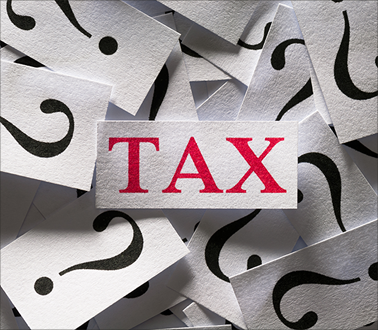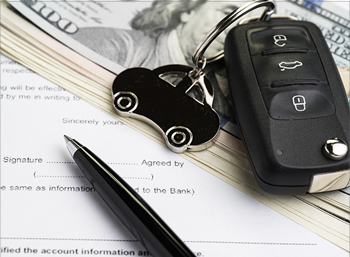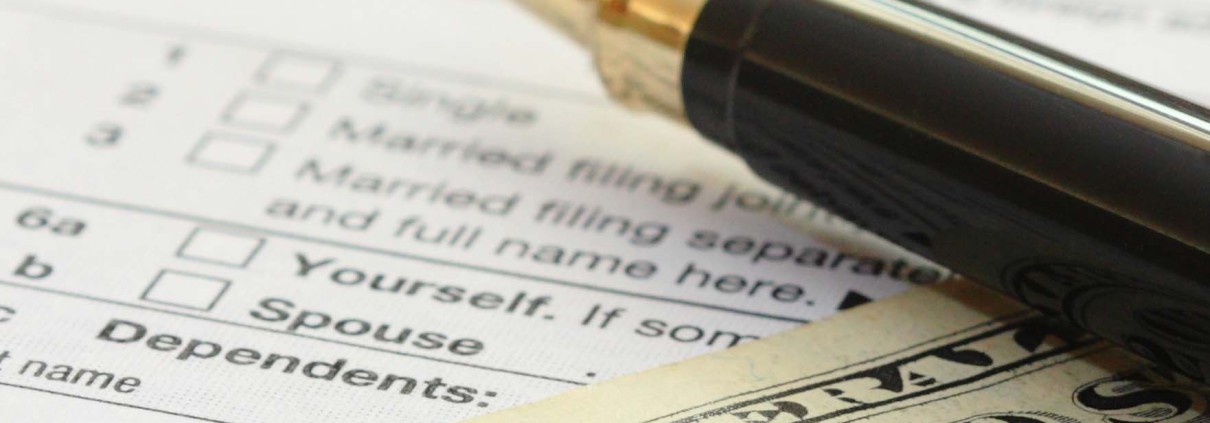April 2019
In This Issue:
5 Big Questions People Are Asking
The individual tax deadline of April 15 is fast approaching. Do you have all your tax arrangements in order? Here are five important questions that people are asking.

![]() What happens if I don’t file on time?
What happens if I don’t file on time?
There’s no penalty for filing a late tax return after the deadline if you are set to receive a refund. However, penalties and interest are due if taxes are not filed on time or a tax extension is not requested AND you owe tax.
To avoid this problem, file your taxes as soon as you can because the penalties can pile up pretty quickly. The failure-to-file penalty is 5 percent of the unpaid tax added for each month (or part of a month) that a tax return is late.
![]() Can I file for an extension?
Can I file for an extension?
If you are not on track to complete your tax return by April 15, you can file an extension to give you until Oct. 15 to file your tax return. Be aware that it is only an extension of time to file — not an extension of time to pay taxes you owe. You still need to pay all taxes by April 15 to avoid penalties and interest.
So even if you plan to file an extension, a preliminary review of your tax documents is necessary to determine whether or not you need to make a payment when the extension is filed.
![]() What are my tax payment options?
What are my tax payment options?
You have many options to pay your income tax. You can mail a check, pay directly from a bank account with IRS direct pay, pay with a debit or credit card (for a fee), or apply online for an IRS payment plan.
No matter how you pay your tax bill, finalize tax payment arrangements by the end of the day on April 15.
![]() When will I get my refund?
When will I get my refund?
According to the IRS, 90 percent of refunds for e-filed returns are processed in less than 21 days. Paper filed returns will take longer.
24 hours after you receive your e-file confirmation (or 4 weeks after you mail a paper tax return), you can use the Where’s My Refund?feature on the IRS website to see the status of your refund.
![]() Oops, I forgot a tax document. Now what?
Oops, I forgot a tax document. Now what?
The first thing to do is determine the impact the new information has on your filed return. For example, if you claim the standard deduction and then receive a mortgage interest statement that does not bring your expenses above the deduction threshold, there’s nothing more you need to do. Simply file the statement with your other tax documents.
If, on the other hand, you receive something like a Form 1099 with additional income, you will need to amend the tax return to claim the income. In cases like this, please call in order to review your situation and the timing of the correction.
4 Key Metrics to Fortify Your Business
Even the best, well-prepared business plans can unravel quickly without a process in place to evaluate performance. Creating a scorecard with quality metrics can give you the daily insight you need to successfully run a business without drowning in the details.
Create a scorecard that works
An effective scorecard gives you a holistic view of the state of your business in one report. The report consists of key financial and non-financial metrics to provide a daily look at the health of your business. To be useful, your measures should be concise, available on-demand, and include properly targeted data to help you quickly spot trends and react appropriately.
Effective business metrics to consider right now

![]() Quick Ratio (financial)
Quick Ratio (financial)
Add up your total cash, short-term investments and accounts receivable. Then divide that total by your current liabilities. This is your quick ratio. It’s a simple way to see if you have enough funds on hand to pay your immediate bills. A value of 1.0 or more means your liquid assets are sufficient to cover your short-term debts. A value less than 1.0 may mean you’re relying too heavily on debt to fund your operations or pay expenses.
![]() Retention Percentage (customers)
Retention Percentage (customers)
First, create a list of customers who made purchases this year and a list of customers who made purchases last year. Then, remove all new customers gained in the current year. Divide the total number of customers from last year by the remaining number of customers for this year. This is your customer retention percentage. Measure this over time to see if your business is retaining or losing core customers. If you have a condensed sales cycle, you can shrink the period down further. For example, by looking at this calculation each month, you can see how it builds over the year.
![]() Asset Turnover Ratio (internal process)
Asset Turnover Ratio (internal process)
Divide your total sales by average total assets from your company balance sheet. (beginning assets plus ending assets, divided by two) for the same time period. The end result tells you the amount of sales generated for each dollar committed to your assets. The number may not reveal much by itself, but when reviewed over time, you’ll have a better understanding of whether the assets used to run your business are becoming more or less effective.
![]() Net Income Per Employee (growth)
Net Income Per Employee (growth)
Divide your net income by your total number of employees for a given time period. In theory, as your workforce develops, it should generate more income per employee. Remember to account for part-time employees prior to making your calculation (e.g., a part-time employee working 20 hours per week is 1/2 an employee for purposes of this calculation). If the income per employee is getting lower over time, figure out why. Perhaps you have high employee turnover, or there is an area of your company that can benefit from training.
While each ratio may help you analyze different aspects of your business, they don’t tell you the whole story. Finding the right mix of metrics for your scorecard can take some time, but the end result is a valuable tool that can take your business to the next level.
Leasing vs. Buying a Car
Knowing the tricks makes you a better decision-maker
There are many reasons for you to lease a car versus buy a car, but too often it is the auto dealer’s profit motive that determines which method you use rather than what’s best for your budget and lifestyle. To help you make an informed decision, here are some things to consider:
When to lease
- You want a car with lower down payments and monthly costs.
- You don’t like making your own vehicle repairs.
- You prefer a new car every couple of years.
- You don’t drive many miles each year.
- You are not hard on your vehicle.
When to buy
- You plan to have the vehicle for many years.
- You are willing to drive a used car.
- You drive more miles than a lease allows.
- You are worried about keeping the car in excellent condition.
- You want to work on or modify the car.
Tips to know if you decide to lease
If you think leasing a vehicle is an option for you, here are some tips to ensure you are making the best deal:

![]() Negotiate before revealing your intentions.Negotiate the price before telling the dealer you wish to lease. The purchase price you negotiate should be the price the dealer uses in calculating the lease payments as well as an outright purchase. If it is not, this technique forces the dealer to disclose this fact.
Negotiate before revealing your intentions.Negotiate the price before telling the dealer you wish to lease. The purchase price you negotiate should be the price the dealer uses in calculating the lease payments as well as an outright purchase. If it is not, this technique forces the dealer to disclose this fact.
![]() Ask about the annual percentage rate (APR).Ask the dealer to disclose the effective APR built into the lease. If the dealer gives you a lease factor instead of an interest rate, multiply the lease factor by 2,400 to get a general interest rate. For example, a lease factor of 0.0025 multiplied by 2,400 returns an interest rate of 6 percent.
Ask about the annual percentage rate (APR).Ask the dealer to disclose the effective APR built into the lease. If the dealer gives you a lease factor instead of an interest rate, multiply the lease factor by 2,400 to get a general interest rate. For example, a lease factor of 0.0025 multiplied by 2,400 returns an interest rate of 6 percent.
![]() Question the residual value.Ask what the projected residual value of the car is at the end of the lease. This value is often overstated by the dealer to artificially lower your lease payment, but can impact your ability to purchase your vehicle at the end of the lease. Future residual value is an estimate and can often be negotiated with the dealer.
Question the residual value.Ask what the projected residual value of the car is at the end of the lease. This value is often overstated by the dealer to artificially lower your lease payment, but can impact your ability to purchase your vehicle at the end of the lease. Future residual value is an estimate and can often be negotiated with the dealer.
![]() Compare with a loan.Use the negotiated purchase price to calculate your loan payments. Use this information to compare your monthly lease payment with your car loan payment.
Compare with a loan.Use the negotiated purchase price to calculate your loan payments. Use this information to compare your monthly lease payment with your car loan payment.
![]() Read the lease agreement!If ever there is a time to read the fine print, leasing a car is one of them. Pay special attention to early termination clauses and cost for excess miles. These two factors can dramatically impact your lease versus buy decision.
Read the lease agreement!If ever there is a time to read the fine print, leasing a car is one of them. Pay special attention to early termination clauses and cost for excess miles. These two factors can dramatically impact your lease versus buy decision.





